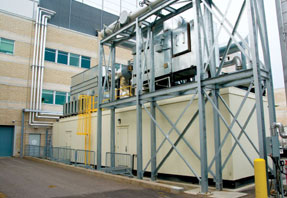As Thunder Bay Regional Health Sciences Centre (TBRHSC) continues to grow due to increasing community demands and its role as an academic health sciences centre, the hospital needed to re-evaluate alternatives to meeting energy demands.
Typically, a hospital uses up to three times the energy of a commercial building because of the 24/7 energy demand, including heating and cooling. Hospitals operate on fixed budgets and the rapid increases in the price of energy in recent years have created challenges for many hospitals.
Hospitals by nature are high-energy consumers. This plant will help them deliver better care at a lower cost,” said Brian Del Vecchio, Senior Account Executive, Johnson Controls.
We're currently saving anywhere from $70,000 to $90,000 per month on our energy costs with cogeneration
Customer Profile
Location: Thunder Bay, ON
Application: Hospital
Equpiment: G3516H Natural Gas Generator
 Thunder Bay Regional Health Sciences Centre - The CHP project provides major energy and financial savings for TBRHSC that can be diverted to support patient care
Thunder Bay Regional Health Sciences Centre - The CHP project provides major energy and financial savings for TBRHSC that can be diverted to support patient care
TBRHSC worked with Thunder Bay Hydro and Johnson Controls to develop and implement a combined heat and power (or cogeneration) plant in the hospital. Combined Heat and Power (CHP) is the simultaneous production of two different forms of energy, heat and electricity from a single input energy. Heat recovered from the plant’s internal combustion engine is not released into the air as waste, but instead used to produce hot water, thereby eliminating the additional use of boilers and fuel. “There are many benefits for not only the TBRHSC but also for the patients and families in Northwestern Ontario”, said Anne-Marie Heron, Executive Director of Capital Planning and Operations, TBRHSC. “The CHP project provides major energy and financial savings for TBRHSC that can be diverted to support patient care.”
At the end of 2015, TBRHSC installed a Combined Heat and Power (CHP) plant powered by a Caterpillar G3516H generator set to increase energy efficiency and reduce the reliance on utility power. Since the installation, the CHP plant has proven to be an efficient way to generate electricity and thermal energy, and will offer tremendous economic and environmental benefits.
“With a daily average of 420 patients plus a staff of 2,500, the demand for electricity and hot water is constant, says Allan Korol, physical plant manager for TBRHSC. “Cogeneration is a good fit for a big building such as ours,” Korol said. “This facility is full of patients 24 hours a day, seven days a week and 365 days of the year. So the need for energy is continuous. The fact that natural gas is fairly reasonably priced and electricity in Ontario is expensive and getting more expensive makes this an attractive proposition for us.”
The CHP plant produces more than 16 million kWh of power and approximately 50 billion BTUs of heat per year. During peak use periods, the hospital requires 4.2 MW of power, and an average of 3 MW. The cogeneration system supplies about 75 per cent of the hospital’s power needs and the plant provides supplemental electrical power in the event of a power outage. “We’re currently saving anywhere from $70,000 to $90,000 per month on our energy costs with cogeneration. And our savings are projected to increase in the future as electricity rates escalate,” said Korol.
Thermal Efficiency
Heat recovered from the G3516H generator engine is not released into the air as waste, but instead is captured and used to produce hot water, thereby reducing the costly use of boilers and fuel. Waste heat from the engine is utilized in both high temperature and low temperature loops. The high temperature loop, which is in the 190 °F range, is injected directly into the boiler supply that provides hot water for the whole facility.
The low temp loop is used for preheating reverse osmosis water that is utilized in humidification and boiler makeup water through a heat exchanger. The low temp water is utilized in two air handlers that preheat the air before a glycol system completes the process. Utilizing the waste heat cuts in half the amount of energy required to operate four water boilers.
 The cogeneration system supplies about 75 per cent of the hospital’s power needs
The cogeneration system supplies about 75 per cent of the hospital’s power needs
“The low temp loop is just the icing on the cake,” said mechanical power engineer James Cole. “Waste heat from the generator also increases the efficiency of the steam boilers. Altogether, the combined efficiency realized from the Toromont cogeneration plant is in the high 80s,” Cole said.
The G3516H generator set and switchgear are housed in an outdoor sound and weather enclsoure adjacent to the hospital. The Cat Switchgear is designed for utility paralleling with islanding capability. It controls and monitors the entire CHP system and includes both generator and utility protection. To meet environmental standards, a Selective Catalytic Reduction (SCR) system placed on the roof of the enclosure reduces NOx emissions from 70 to 80 parts per million down to 30 parts per million. A 100-foot stack sends the exhaust past the roofline of the four-story hospital.
“We’re meeting all Ontario Ministry of the Environment requirements with regard to emissions to the atmosphere and noise abatement,” Korol says.
Toromont Ensures High Uptime
In order to maximize savings, the generator set needs to run 24-hours a day. Currently, uptime is a reliable 95 per cent, with only periodic shutdowns for planned maintenance. Hospital building system operators monitor the cogeneration enclosure two to three times during each 12-hour shift and take critical readings that have been recommended by Toromont Power Systems. “We monitor the operation, and look for changes,” Korol says. “We have cameras set up to monitor inside the cogen enclosure,” Korol says. “It’s a confidence builder for us and a good way to keep an eye on this piece of equipment.”
Since the Caterpillar G3516H was put into service, the hospital’s building system operators have become well versed at operating the generator set.
“Toromont’s presence has proven to be dependable,” Korol says. “We call them anytime day or night and there’s always somebody here within an hour or so, so we have a good on-call support system to help us resolve any operating issues.” Having a maintenance and repair contract is critical because it enables TBRHSC to forecast how much they will need to spend over the next 10 years maintaining the cogen system, so they can budget accordingly.
“Toromont won that competitive process, and I think a big part of it is that Caterpillar makes an established product with a track record of reliability that is as good or better than anybody else,” Korol says. “Toromont has a major service presence here in Northern Ontario, and that aligns well with our requirements.”
Related Projects
Additional Resources